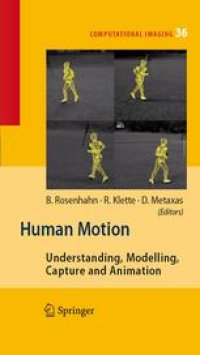
Ebook: Human Motion: Understanding, Modelling, Capture, and Animation
- Tags: Computer Imaging Vision Pattern Recognition and Graphics, Image Processing and Computer Vision, Human Physiology, Sports Medicine
- Series: Computational Imaging and Vision 36
- Year: 2008
- Publisher: Springer Netherlands
- Edition: 1
- Language: English
- pdf
Edward Muybridge (1830–1904) is known as the pioneer in motion capt- ing with his famous experiments in 1887 called “Animal Locomotion”. Since then, the ?eld of animal or human motion analysis has grown in many dir- tions. However, research and results that involve human-like animation and the recovery of motion is still far from being satisfactory. The modelling, tracking, and understanding of human motion based on video sequences as a research ?eld has increased in importance particularly in thelastdecadewiththeemergenceofapplicationsinsportssciences,medicine, biomechanics, animation (online games), surveillance, and security. Progress in human motion analysis depends on empirically anchored and grounded research in computer vision, computer graphics, and biomechanics. Though these ?elds of research are often treated separately, human motion analysis requires the integration of methodologies from computer vision and computer graphics.Furthermore,theunderstandinganduseofbiomechanicsconstraints improves the robustness of such an approach. This book is based on a June 2006 workshop held in Dagstuhl, Germany. This workshop brought together for the ?rst time researchers from the afo- mentioned disciplines. Based on their diverse perspectives, these researchers havebeendevelopingnewmethodologiesandcontributing,throughtheir?- ings, to the domain of human motion analysis. The interdisciplinary character of the workshop allowed people to present a wide range of approaches that helped stimulate intellectual discussions and the exchange of new ideas.
The study of human motion dates back more than 2000 years. With the event of information technology, new areas have been added to this field. Research using computer vision and computer graphics contributes to a transformation of biomechanics into a discipline that now applies computing technology throughout. On the other hand, computer vision and computer graphics also benefit from defining goals aimed at solving problems in biomechanics. Besides interactions, all three areas also developed their own inherent research dynamics towards studying human motion.
Researchers from all three of these areas have contributed to this book to promote the establishment of human motion research as a multi-facetted discipline and to improve the exchange of ideas and concepts between these three areas. Some chapters review the state-of-the-art whilst others report on leading edge research results, with applications in medicine, sport science, cinematography and robotics.